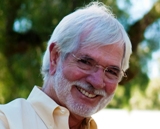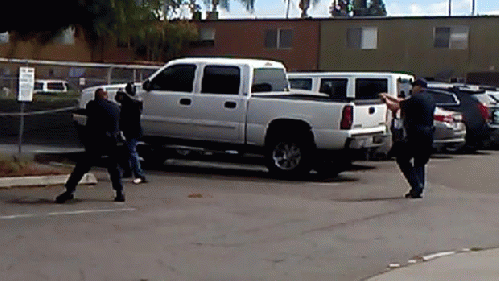From amongst themselves, the People of the United States have empowered some of their members to enforce their laws and to police their society, but things have gone terribly awry. The police are killing those they are sworn to protect and they themselves are becoming the target of public anger over racial inequality and discrimination. Video images of recent police shootings in Louisiana and Minnesota were followed by the mass murder of police officers in Dallas and Baton Rouge, apparently in response to these shootings
The killing of an unarmed mentally-disturbed man last week by El Cajon, California police officers--and resulting civil disturbances--once again raises the question of the use of deadly force by law enforcement officers. The question involves complicated issues of law and policy, but the decision to shoot must often be made in a nanosecond. With the widespread availability of video cameras, instant playback, and social media, however, the justification for the use of deadly force is being increasingly scrutinized, and the quality of law enforcement policy, training, and discretion is frequently found wanting.
The reasonableness of a police shooting decision is determined by what was known to the officer at the moment of the shooting, and whether that decision complied with policy and law. The decision to pull the trigger is made by an individual officer, but the responsibility for its consequences is shared by the policing agency. Based on experience, professional standards, statutory and constitutional law, and public expectations, police policy and training seeks to minimize the risk of harm to the public while ensuring the right of self defense. There are no easy answers, but it is essential that police administrators learn from these encounters and formulate more effective policy and training to guide their officers and to hold them accountable.
Background. My 45-year career in the justice system began in 1962 when I became a police officer in El Cajon. The new chief of police (who was later elected sheriff of San Diego County) was intent on improving the level of professionalism in the department. Proud to be a part of the "New Breed," I achieved top honors in the San Diego Police Academy and quickly became president of the Police Officer's Association and later president of the San Diego County organization representing all of its law enforcement officers. Although El Cajon was a quiet suburb, police work was not without its risk. One of my supervisors, Sergeant Fred Wilson-- the only El Cajon police officer ever killed in the line of duty--later died of head injuries he sustained breaking up a fight.
Transferring to the Los Angeles Police Department in 1968, I again achieved top honors in the Police Academy and was assigned to South Central LA upon graduation, where policing was more dangerous. My partner and I were once dispatched to a "man with a gun" call from only a block away, and as we turned the corner, we saw the man directly in front of us in the street. He was holding a woman by her hair in one hand and a gun in the other. He shot her in the abdomen, looked up, saw us, and began to run between the houses. I drew my revolver and chased after him. He jumped up on a wall and threw his weapon to the other side, but drew another handgun from his waistband as he came back down. Crouched in a firing stance, I yelled at him to drop the second gun and he did. We arrested him, and his girlfriend was transported to the hospital. Later, my tactics were criticized for not having shot the man. In cop terms, it would have been a "good," or justifiable, shooting, but in my mind he was just trying to get rid of his guns, and I had no cause to shoot him.
I was fortunate that day, but two of my friends were not so lucky. Jerry Maddox, with whom I had carpooled to the Police Academy, was shot to death in 1969 by a gang member in East LA, and Jack Coler was one of the FBI agents ambushed and murdered at Wounded Knee in 1975.
Drafting Policy. Upon completion of my probation, I was transferred to LA police headquarters where I spent two years researching and writing the department Policy Manual. Subsequently, while attending night law school, I was also assigned to work on the Police Task Force of the National Advisory Commission on Criminal Justice Standards and Goals. My job was to write about the role of the police in America and law enforcement policy making. As the author of the LAPD shooting policy, I later testified at the Police Commission hearing into the shooting of Eulia May Love in 1979. When the city attempted to turn off her gas for nonpayment, the recent widow had the payment in her purse as she waved a knife to keep the gas man at bay. Two officers responded and shot her eight times.
The drafting of shooting policy began with the law of justifiable homicide. A police officer can legally kill in three circumstances: self defense, defense of others, and to prevent the escape of a fleeing felon. Although there have been some minor revisions, the Los Angeles Police Department shooting policy remains the same as originally written. The policy does not limit the right of an officer to shoot in self defense. It does, however, require that "Justification for the use of deadly force must be limited to what reasonably appear to be the facts known or perceived by an officer at the time he decides to shoot." Moreover, policy states that a "reverence for the value of human life shall guide officers in considering the use of deadly force," and it imposes a duty on officers to minimize "the risk of death." The shooting of fleeing felons is limited to those who have caused "serious bodily injury or the use of deadly force where there is a substantial risk" that the felon will "cause death or serious bodily injury to others. . . ."
In a section titled "Minimum Use of Force," LAPD officers are told they "should use only the reasonable amount of physical force which is necessary on any particular occasion for achieving a police objective."
These Los Angeles Police Department use-of-force policies generally follow California law, and it may be helpful to consider the known facts of the recent El Cajon police shooting in light of these basic principles. Unlike the Los Angeles Police Department Manual--which is generally available in public libraries--the policies of the El Cajon Police Department are not published. It appears, however, that El Cajon's policies may be based on those of Los Angeles. The ECPD website states that "The Department serves the people of El Cajon by performing in a professional manner; and it is to the people of this community that the Department is ultimately responsible." Except for the city's name, this mission statement is identical with the definition of the LAPD motto, "To Protect and To Serve" I originally wrote in the Policy Manual.
El Cajon Shooting Facts. On September 27, 2016, the sister of Alfred Olango, a 30-year-old refugee from Uganda, called the El Cajon Police Department seeking help with her brother--who was having an emotional breakdown over the death of his best friend. Two other calls to the department reported that a shirtless man was walking in traffic and acting erratically at the same location. Although located less than two miles from police headquarters, it took officers more than an hour to respond.
Richard Gonsalves, a 21-year veteran officer--who had been recently demoted from sergeant for sexually harassing a female officer--was the first to arrive on the scene in the parking lot of a small strip mall. A surveillance camera shows that he immediately drew his weapon and closely confronted Olango, who continued to pace back and forth with his right hand in his pocket. According to the officer, Olango did not obey repeated orders to remove his hand from his pocket. A second officer arrived and drew his taser weapon instead of his firearm. As Olango's sister approached the scene, Olango suddenly withdrew his hand holding an electronic smoking device from his pocket and extended it towards Officer Gonsalves. He was immediately shot four times by Gonsalves and tased by the other officer. The entire encounter lasted less than one minute.
Tactics. Although the El Cajon Police Department has released the surveillance video and another contemporaneous video made with a bystander's cellphone, the calls to the police and the radio dispatch have not been released. It is essential to know exactly what Olango's sister and other callers told the police dispatcher and what the responding officers were told. One standard question asked of most complainants is whether a person is armed. Although a vape pipe might appear to be a small gun, it matters whether the police were originally informed that the person was waving a gun or smoking a vape pipe. There is also a great difference if the responding officers were told that they were dealing with a mental case--or a serious crime such as an armed robbery. Inasmuch as it took more than an hour for the officers to arrive, and the matter was dispatched as a "5150" call regarding a mentally disturbed individual, there is no evidence that a crime of violence was under consideration.
Depending on the information available to Officer Gonsalves, it is questionable whether he should have drawn his gun in the first place. The LAPD shooting policy tells officers they cannot "draw or exhibit a firearm unless the circumstances surrounding the incident create a reasonable belief that it may be necessary to use the firearm" in conformance with written policy. Nor are officers allowed to use deadly force "to protect themselves from assaults which are not likely to have serious results."
Officers are trained to demonstrate "command presence" and to quickly take control of situations. Officers must deliver firm and unambiguous directions--which may in some cases require a loud voice and even profanity. If, however, Officer Gonsalves believed he was dealing with a mental case, he should have been trained as a professional to de-escalate and defuse the situation by speaking in a calm voice and by asking questions, rather than shouting commands. Asking Olango what he had in his pocket, or if he would show his empty hand, is different than a loud order to remove his hand (along with the pocket contents).
(Note: You can view every article as one long page if you sign up as an Advocate Member, or higher).






